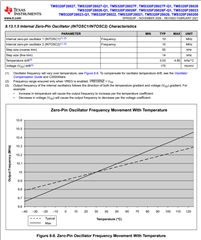Hi Team C2000,
The only reference I can find for the accuracy of the TMS320F28027F internal Zero-Pin Oscillator INTOSC1/INTOSC2 and resulting PLL Clock Accuracy.. is in the datasheet fig 8-8 which is a chart of "Zero-Pin Oscillator Freq Movement w/ Temperature".. am I missing the spec of the overall INTOSC1/2 accuracy?
Thanks, Merril

Ref:
https://www.ti.com/lit/ug/sprui09/sprui09.pdf
https://www.ti.com/lit/er/sprz292s/sprz292s.pdf

